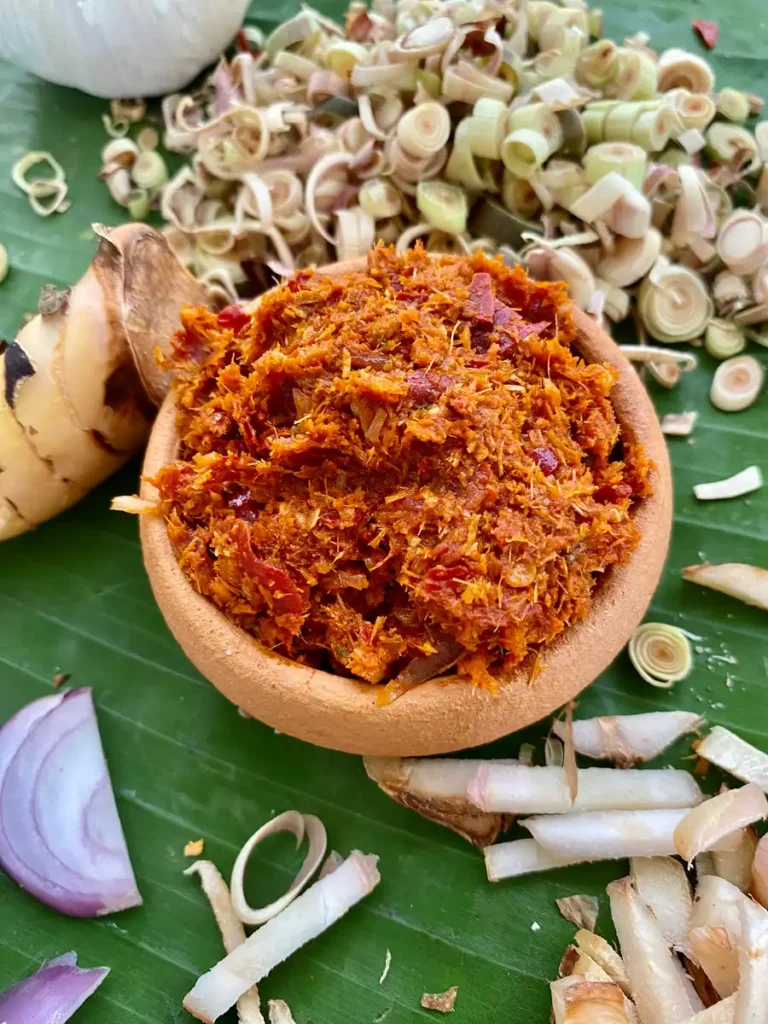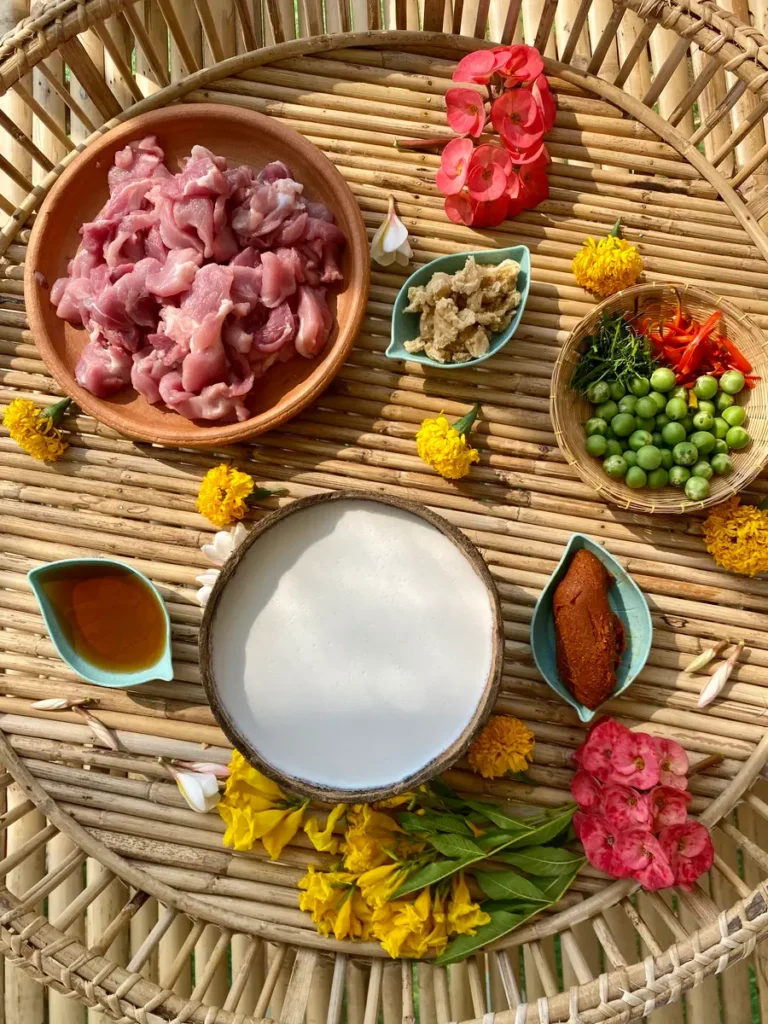Authentic panang curry recipe with homemade curry paste and a creamy coconut sauce for that Thai restaurant quality at home. It’s enriched with kaffir lime leaves and has a perfect mix of mildly spicy, sweet, and umami flavors.

Once you find out how easy it is so make traditional Thai curries at home, you’ll never want takeout again! My recipes guide you through making classic Thai green curry, authentic Thai red curry, and Thai massaman chicken curry at home.
Authentic panang curry
Panang curry, also known as phanaeng curry, is a classic dish from central Thailand that’s loved all around the word. It’s known for its rich aroma and comforting taste.
As with many authentic Thai dishes, like chicken pad Thai, some versions you find will stray far from the authentic dish. Some recipes add peanut butter, or lots of vegetables like bell peppers, carrots, and mushrooms.
An authentic panang curry is actually all about keeping things simple. There are close to no vegetables, as it focuses on protein and kaffir lime leaves, mixed with palm sugar and fish sauce for a mix of sweet and umami flavors.

To get the most traditional taste, making your own panang curry paste from scratch with a mortar and pestle is the best thing. This way, you can also adjust the spiciness of the curry paste to your liking.
Serve it over rice or vermicelli noodles – if you love creamy, sweet, and nutty tastes, this dish is for you!
Homemade panang curry paste
My Thai panang curry paste is the real deal. You can make a healthy and authentic mixture of fresh spices and herbs yourself if you have time. Traditionally, we use a granite mortar and pestle, but you can use a food processor if you’re short on time or for convenience.

You’ll need a bunch of ingredients, but it’s so worth it: dry red spur chilies, dried chilies, shallots, lemongrass, galangal, garlic, kaffir lime zest, salt, shrimp paste, cumin, coriander seeds. You can find most of them at Asian grocery stores and Asian markets.
Ingredients
Ingredients can be sourced at Asian grocery stores and Asian markets.
The exact measurements are in the recipe card at the end of this post.

- Panang curry paste – For store bought, use Mae Ploy or Maesri.
- Coconut milk – Authentic panang is supposed to have a thicker curry sauce, so it’s essential to opt for full-fat coconut milk.
- Pork – Pork tenderloin and shoulder are great cuts for this recipe. Alternatively, you can use chicken, beef, tofu, duck, turkey, shrimp, prawns, or other seafood.
- Fish sauce – One of the key ingredient in Thai cuisine, adds umami and a savory flavor to the panang sauce.
- Palm sugar – The secret behind the delicious nutty caramel-like sweetness in panang curry lies in the use of palm sugar. Its flavor is distinct from white and brown sugar, and it’s my go-to for Thai curries.
- Pea eggplants (optional) – Pea eggplants are optional, since some traditional preparations don’t include vegetables. I like the satisfying crunch they bring, and the extra flavor.
- Red chili peppers – For a mild curry, opt for Spanish long red chilies – they’re only mildly spicy. For a spicier curry, go for Thai jinda or bird’s eye chilies. In my family, we remove the seeds and slice them into thin strips.
- Kaffir lime leaves – A key ingredient for adding a citrusy flavor and aroma. I like cutting them into thin strips.
Cooking instructions
My grandmother taught me the traditional way to cook panang curry. We start by separating the coconut oil from the coconut milk, which thickens it and gives the curry its classic rich texture.

Step 1: Stack a few kaffir lime leaves, roll them tightly, and slice into thin strips with a sharp knife.

Step 2: In a non-stick wok or pot over medium heat, pour a bit more than 1/3 of the coconut milk. No oil needed. Stir occasionally to keep it from burning. Soon, the coconut milk will thicken and oil starts to show on the surface. Don’t bring it to a full boil, just a gentle simmer.

Step 3: Stir in the curry paste until it’s well mixed with the coconut milk.

Step 4: Add the rest of the coconut milk and mix well. Bring to a boil and then add palm sugar, fish sauce, and your protein. Give it a stir to ensure the pork doesn’t stick together. Allow the curry to simmer until the pork is cooked, typically about 3-4 minutes.

Step 5: Toss in pea beans, sliced kaffir lime leaves, and chilies, and cook for another 2 minutes. Serve right away with a portion of rice or vermicelli noodles. Enjoy!
Kitchenware
- Thai mortar and pestle or a food processor for making homemade curry paste
- Cutting board and a sharp knife
- Measuring spoons and cups
- Stirring spoon or spatula
- Cooking pot or deep wok
Customize Thai pork curry
Vegetables: While authentic panang curry doesn’t have many veggies, you can still add some if you like. Try bell peppers, Thai eggplants, yard long beans, green beans, basil, and broccoli. Just keep in mind, the classic way to make panang isn’t with a ton of vegetables.
Vegetarian: Use tofu instead of meat, and pick a vegetarian fish sauce instead of the regular fish sauce.
Proteins: In Thailand, for many Thai food pork preferred protein is pork as it has a good balance of meat and fat. But feel free to use whatever you like, like chicken thighs, beef, shrimp, squid, or any seafood will just be as delicious.
Pork panang curry serving suggestions
This Thai pork curry is perfect with steamed jasmine rice or rice vermicelli noodles to soak up all that creamy coconut curry sauce. You can serve them in a separate bowl alongside the curry, or ladle the curry over the rice or noodles.
Feel free to add a garnish of some fresh herbs like Thai basil or even sliced red chilies. For a complete meal, you can serve it with Thai roti, a staple in Southern Thailand.
How to store panang pork
Once your leftovers have cooled to room temperature, transfer them into an airtight container and store it in the fridge for up to 4 days. It’s perfect for meal prep, as curries tend to taste even better the next day. They’re also great for freezing!
Freezing: Use a freezer-safe container or bag and thaw overnight in the fridge.
Reheating: Simply warm it up on the stove or in the microwave until heated through.
Frequently asked questions
Is panang curry spicy?
Panang curry is mildly spicy, but it’s not overwhelmingly spicy like a Thai red curry or green curry can sometimes be.
What makes panang curry different?
Panang curry is thicker, sweeter, and less spicy than most Thai curries, with a nutty peanut flavor.
Is panang curry vegan?
It can be made vegan by using tofu instead of meat and substituting fish sauce with a vegan alternative.
Is panang curry gluten-free?
Panang curry can be gluten-free if you don’t use soy sauce and ensure your other ingredients are gluten-free.
Does panang curry have peanuts?
Yes, peanuts are a key ingredient, giving it a distinctive nutty taste. However, the peanuts are typically ground in the curry paste?
Is panang curry healthy?
Panang curry can be healthy, containing vitamins and minerals from its ingredients, but it’s also high in calories and fat due to coconut milk and peanuts.
Authentic Thai curry recipes
- Vegetarian Thai green curry
- Thai bamboo shoot curry
- Gaeng massaman neua
- Thai mushroom curry
- Gaeng panang gai
Loved reading this authentic panang curry recipe? Please make my day by dropping a star rating and/or a comment below! Follow me on Facebook, Instagram, and Pinterest.
Authentic Panang Curry Recipe

Ingredients
- 2 cups coconut milk
- 3 tbsp panang curry paste, see notes
- 2 1/4 cups pork, tenderloin or shoulder, thin sliced
- 2 1/2 tablespoons palm sugar
- 4 tablespoons fish sauce
- 1 handful pea eggplants, optional
- 4 kaffir lime leaves, sliced into thin strips
- 3 chilies, see notes
Instructions
- Stack a few kaffir lime leaves, roll them tightly, and slice into thin strips with a sharp knife.
- In a non-stick wok or pot over medium heat, pour a bit more than 1/3 of the coconut milk. No oil needed. Stir occasionally to keep it from burning. Soon, the coconut milk will thicken and oil starts to show on the surface. Don’t bring it to a full boil, just a gentle simmer.
- Stir in the curry paste until it’s well mixed with the coconut milk.
- Add the rest of the coconut milk and mix well. Bring to a boil and then add palm sugar, fish sauce, and your protein. Give it a stir to ensure the pork doesn’t stick together. Allow the curry to simmer until the pork is cooked, typically about 3-4 minutes.
- Toss in pea beans, sliced kaffir lime leaves, and chilies, and cook for another 2 minutes. Serve right away with a portion of rice or vermicelli noodles. Enjoy!
Notes
- Use the nutrition card in this recipe as a guideline.
- Panang curry paste - For store bought use Mae Ploy or Maesri.
- Chilies - For a mild curry, opt for Spanish long red chilies - they're only mildly spicy. For a spicier curry, go for Thai jinda or bird's eye chilies. In my family, we remove the seeds when making panang curry, and then slice the chilies into thin strips.







Could you describe what Pea eggplants are?
Also, you said that peanut so traditional, but you didn’t put them in your recipe. Should I just throw in a handful at the end or do they get added earlier on?
Hey Betsy! Adding peanuts to the curry itself is not correct, as they are typically ground in the curry paste. You can use my recipe for panang curry paste to make the paste with peanuts.
Synonyms for pea eggplants are: Solanum torvum (Turkey berry). You can easily find an image if you google ‘pea eggplants’. It’s not a must in this recipe, however, I like the structure they bring. Hope this helps!